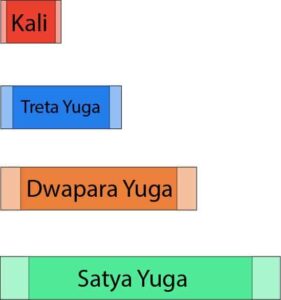
Dvapara yuga is the bronze age, the third of the four yugas. To understand what is Dvapara yuga, we will discuss its duration, the different Vishnu avatars that appear in it, as well as other important symptoms. It is a time when humanity’s social systems begin to break down and the principles of righteousness start to weaken. A yuga is a cosmic age according to the Vedic system of measuring universal time. The four yugas are Satya Yuga, Treta Yuga, Dvapara Yuga, and Kali Yuga. Together they comprise one full yuga cycle, and one thousand Yuga cycles is equal to a day of Brahma, also known as a kalpa.
The Duration of Dvapara Yuga
In Vedic cosmology, various regions within the universe experience time differently due to the phenomenon of time dilation. For example, one year in the realm of Svarga is approximately equal to 720 solar years on our planet Earth.
For this reason, the Vedas give two different measurements for the duration of Dvapara Yuga. In years of the devas, Dvapara Yuga lasts 2,400 years, and on Earth, it lasts 1.728 million years. The duration of Dvapara Yuga is described in the Vayu Purana as follows:
anuṣaṅgapādastretāyāstrisāhasrastu saṃkhyā /
dvāpare dve sahasre tu varṣāṇāṃ samprakīrttitaṃ //
tasyāpi dviśatī saṃdhyā saṃdhyāṃśo dviśatastathā /
upodaghātastṛtīyastu dvāpare pād ucyate //
“Tretā Yuga, which is also called the Anuṣaṅgapāda, consists of three thousand years and Dvāpara Yuga consists of two thousand years. The Saṃdhyā consists of two hundred years and the Saṃdhyāṃśa is of the same duration. Dvāpara Yuga, which is the third part of the Chaturyuga, is also called Upodaghātapāda.” (VP 1.32.58-59)
The most recent Dvapara Yuga ended approximately 10,000 years ago.
| Time Unit | Solar Years |
|---|---|
| Kali Yuga | 0.864 million years |
| Treta Yuga | 1.728 million years |
| Dwapara Yuga | 2.592 million years |
| Satya Yuga | 3.456 million years |

General Overview
By the end of Treta Yuga, human beings began to stray from the path of dharma, or the religious way of life. Members of society exploited their positions to increase their own stature and standard of happiness at the expense of those around them. This was occurring at all levels of society, from brahmana priests to working-class sudras. Wars began to break out as ruling kshatriya kings vied for power, wealth, and influence. No longer able to effectively perform collective sacrifice, human beings instead took up the worship of Vishnu in His deity form. Thousands of temples were constructed throughout the world for the worship of the Supreme Person, Vishnu, as well as His demigod expansions, such as Indra, Agni, Shiva, etc.
Dvapara Yuga, or the Bronze Age, saw the first instances of selfishness and irreligion overcoming mankind’s natural godly nature. The scales began to tip in favor of godlessness, and people became fearful and mistrusting of their leaders and fellow citizens. However, there were still many holy kings on earth who upheld justice and defended virtue. In Dvapara Yuga, human beings live up to 1,000 years.
Toward the end of the most recent Dvapara Yuga, Mother Earth became overburdened by corrupt leaders who had all but completely abandoned the path of religiosity in favor of wanton selfishness and blind violence. Mother Earth assumed the form of a helpless cow and approached Lord Brahma, the universal creator, pleading to him to intervene on her behalf and for the welfare of the human race. Brahma then made an appeal to Vishnu, who informed him that the Supreme Personality of Godhead, Krishna, would appear on Earth to destroy the evil kings and restore virtue to the world. It was at this time that Krishna made His descent and spoke the famous Bhagavad-gita to Arjuna.
Recommendation for Dvapara Yuga
In the Bhagavata Purana, recommendations for spiritual elevation are given for each age:
Whatever result was obtained in Satya Yuga by meditating on Vishnu, in Treta Yuga by performing sacrifices, and in Dvapara Yuga by worshiping the Deity can be obtained in Kali Yuga simply by chanting the Lord’s names. (Bhagavata Purana 12.3.52)
Thus, serving a personal deity form of Lord Vishnu is prescribed as the most effective means for liberation and spiritual growth in the Dvapara Yuga.
Would you like to try meditating on serving the deity? Read this article on meditation to learn more about it.
Avatara for Dvapara Yuga
In each Yuga, there is a specific avatara of Krishna who descends to guide humankind. As Krishna tells Arjuna in Bhagavad-gita 4.8:
To deliver the pious and to annihilate the miscreants, as well as to reestablish the principles of religion, I Myself appear, millennium after millennium.
In Dvapara Yuga, the Supreme Personality of Godhead appears with a dark blue complexion, wearing yellow garments. The Lord’s transcendental body is marked in this incarnation with Śrīvatsa and other distinctive ornaments, and He manifests His personal weapons. For more information, see our article, Avatars of Dvapara Yuga.
LEARN MORE: The Puranas provide an advanced understanding of our universe, including descriptions of life on other planets. Check out our guide to Vedic Cosmology.
What Comes Next?
After Dvapara Yuga is Kali Yuga, the Iron Age. Kali Yuga lasts 1,200 years of the devas, or 864,000 human years. Check out our article to learn more about Kali Yuga.